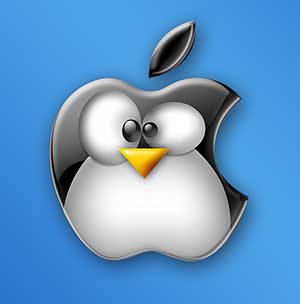
The open-source project that first came up with a way to dual-boot an Intel-based Mac into either Mac OS X or Windows XP has published instructions on how to add Linux to the mix.
“Triple Boot,” as the OnMac.net Web site calls it, relies on the newly-released Boot Camp, Apple Computer Inc.’s dual-boot utility that created a major stir when it debuted two weeks ago. The process is involved and not for the technically faint-of-heart, as it “chainloads” Linux from an already-installed copy of Windows XP using the “LILO” bootloader.
The instructions on how to triple-boot an Intel Mac can be read on the OnMac.net site. The process has been tested on a MacBook Pro, Apple’s Intel-based portable, but not on the Mac mini or iMac models.
Rock on! And for folks using PowerPC-based Macs, there’s always Yellow Dog Linux.















Can someone explain why anyone would do this? OSX is based on Unix! Why would anyone need two versions of Unix running on their computer?!
Advice: if you think this sounds daunting…
“The process is involved and not for the technically faint-of-heart, as it “chainloads” Linux from an already-installed copy of Windows XP using the “LILO” bootloader.”
Don’t waste your time on Linux, it is not a desktop OS it is a command line OS with a GUI slapped on the top. Great OS for stability, bad OS for non-linux guru status users. I speak from experience having used several distributions. I think the open source model is fantastic however and truly hope that Linux and it’s gazzillion distributions evolve into something usable (and by that I mean auto hardware change detection, easy installer options, up to date GUI, faster boot and shut down, etc…).
Just my opinion.
Re: #2
“GUI OS” doesn’t mean “easy to use from the GUI”. Personally, I always prefer a console OS with a GUI on top, simply because it means I can reboot the GUI without restarting the uptime counter (my main reason) or upgrade it without having to stop and resume any incomplete torrents. (I use rTorrent inside GNU screen for GUI-independant torrenting)
What exatly do you mean by “auto hardware change detection”? Any modern Linux distro which provides a decent kernel and a proper udev setup will auto-detect and enable any hotpluggable device for which a driver is available. As for auto-mounting, just use something like ivman, gnome-volume-manager, or their KDE counterpart, the name of which I forget.
Which distros have you tried? MandrakeLinux 10.0 was easier to install than Windows XP and there are now at least half a dozen general-purpose distros that automate away everything reasonably possible. I’d make a comparison to MacOS X, but the last Mac I owned was a Mac SE with MacOS 7.1
I’m not sure what you mean by “up to date GUI” but I think KDE and GNOME are at least as newbie friendly as Windows XP. Of course, as a power user, I wouldn’t touch GNOME with a ten foot pole. I use either Xfce4 or Fluxbox for my window manager, Konqueror for my file manager, and I a mix of other apps, and I have to say that the only time I ever need to drop into console is for things like regex-based file searches. (I don’t feel like looking for a GUI app to do them)
As for “Faster boot and shutdown”, let’s wait and see what Gentoo Linux and Ubuntu Linux are working toward. They’ve got what I refer to as ‘packed init’ in the works. (A referece to the look of the timeline chart for “after”) The important thing is to not release an incomplete tool. Also, there’s an init tool called init-ng which can analyze and optimize it’s boot process. you could try switching to it.
Stephan, I totally respect the open source movement and think that Linux could be a contendor. My main gripes are the installer proccess for applications and the relieance on terminal input. You need at least a minumal knowledge of the terminal if you want to configure things and get linux as totally funtional as XP / OSX, at least it seems that way to me.
I like using Linux fomr time to time but sadly cant use it as my main OS due to lack of suitable alternative applications to Logic Audio, Photoshop, inDesgin, Dreamweaver, Flash which I currently use on OS X. The main distribution I use is Fedora, since I have never been able to even install Gentoo or any of the ‘real’ linux distributions and Fedora seems to correctly configure at least 80% of my PC hardware, leaving not a great deal to do apart from MP3 support and ALSA configuration, but I still have to go to the terminal to do it! I hope Google do something with linux, I reckon they could make it very easy to use without even needing to look at a terminal. This however, may take away from the open source model and might alienate the Linux community, especially if it is linux served with adverts. To me, the finest OS on the planet is OS X, but then I do like the way Apple do things.